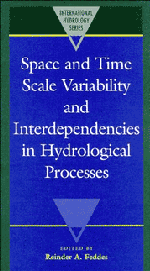Book contents
- Frontmatter
- Contents
- Acknowledgement
- OPENING ADDRESS OF THE FIRST GEORGE KOVACS COLLOQUIUM
- HETEROGENEITY AND SCALING LAND-ATMOSPHERIC WATER AND ENERGY FLUXES IN CLIMATE SYSTEMS
- SCALE PROBLEMS IN SURFACE FLUXES
- REMOTE SENSING – INVERSE MODELLING APPROACH TO DETERMINE LARGE SCALE EFFECTIVE SOIL HYDRAULIC PROPERTIES IN SOIL–VEGETATION–ATMOSPHERE SYSTEMS
- THE IMPORTANCE OF LANDSCAPE POSITION IN SCALING SVAT MODELS TO CATCHMENT SCALE HYDROECOLOGICAL PREDICTION
- THE INFLUENCE OF SUBGRID-SCALE SPATIAL VARIABILITY ON PRECIPITATION AND SOIL MOISTURE IN AN ATMOSPHERIC GCM
- MODELLING THE HYDROLOGICAL RESPONSE TO LARGE SCALE LAND USE CHANGE
- AN APPROACH TO REPRESENT MESOSCALE (SUBGRID-SCALE) FLUXES IN GCMs DEMONSTRATED WITH SIMULATIONS OF LOCAL DEFORESTATION IN AMAZONIA
- A HIERARCHICAL APPROACH TO THE CONNECTION OF GLOBAL HYDROLOGICAL AND ATMOSPHERIC MODELS
- STOCHASTIC DOWNSCALING OF GCM-OUTPUT RESULTS USING ATMOSPHERIC CIRCULATION PATTERNS
- DEPENDENCIES OF SPATIAL VARIABILITY IN FLUVIAL ECOSYSTEMS ON THE TEMPORAL HYDROLOGICAL VARIABILITY
- PROBLEMS AND PROGRESS IN MACROSCALE HYDROLOGICAL MODELLING
- PREDICTABILITY OF THE ATMOSPHERE AND CLIMATE: TOWARDS A DYNAMICAL VIEW
- FROM SCALAR CASCADES TO LIE CASCADES: JOINT MULTIFRACTAL ANALYSIS OF RAIN AND CLOUD PROCESSES
- FRACTALS ET MULTIFRACTALS APPLIQUÉS À L'ÉTUDE DE LA VARIABILITÉ TEMPORELLE DES PRÉCIPITATIONS
DEPENDENCIES OF SPATIAL VARIABILITY IN FLUVIAL ECOSYSTEMS ON THE TEMPORAL HYDROLOGICAL VARIABILITY
Published online by Cambridge University Press: 05 November 2011
- Frontmatter
- Contents
- Acknowledgement
- OPENING ADDRESS OF THE FIRST GEORGE KOVACS COLLOQUIUM
- HETEROGENEITY AND SCALING LAND-ATMOSPHERIC WATER AND ENERGY FLUXES IN CLIMATE SYSTEMS
- SCALE PROBLEMS IN SURFACE FLUXES
- REMOTE SENSING – INVERSE MODELLING APPROACH TO DETERMINE LARGE SCALE EFFECTIVE SOIL HYDRAULIC PROPERTIES IN SOIL–VEGETATION–ATMOSPHERE SYSTEMS
- THE IMPORTANCE OF LANDSCAPE POSITION IN SCALING SVAT MODELS TO CATCHMENT SCALE HYDROECOLOGICAL PREDICTION
- THE INFLUENCE OF SUBGRID-SCALE SPATIAL VARIABILITY ON PRECIPITATION AND SOIL MOISTURE IN AN ATMOSPHERIC GCM
- MODELLING THE HYDROLOGICAL RESPONSE TO LARGE SCALE LAND USE CHANGE
- AN APPROACH TO REPRESENT MESOSCALE (SUBGRID-SCALE) FLUXES IN GCMs DEMONSTRATED WITH SIMULATIONS OF LOCAL DEFORESTATION IN AMAZONIA
- A HIERARCHICAL APPROACH TO THE CONNECTION OF GLOBAL HYDROLOGICAL AND ATMOSPHERIC MODELS
- STOCHASTIC DOWNSCALING OF GCM-OUTPUT RESULTS USING ATMOSPHERIC CIRCULATION PATTERNS
- DEPENDENCIES OF SPATIAL VARIABILITY IN FLUVIAL ECOSYSTEMS ON THE TEMPORAL HYDROLOGICAL VARIABILITY
- PROBLEMS AND PROGRESS IN MACROSCALE HYDROLOGICAL MODELLING
- PREDICTABILITY OF THE ATMOSPHERE AND CLIMATE: TOWARDS A DYNAMICAL VIEW
- FROM SCALAR CASCADES TO LIE CASCADES: JOINT MULTIFRACTAL ANALYSIS OF RAIN AND CLOUD PROCESSES
- FRACTALS ET MULTIFRACTALS APPLIQUÉS À L'ÉTUDE DE LA VARIABILITÉ TEMPORELLE DES PRÉCIPITATIONS
Summary
ABSTRACT Flood plains are regions which are strongly dependent on the hydrological conditions induced by the dynamics of the fluvial water system. These regions also exhibit a broad spectrum of different habitats closely interfaced and of large biological diversity.
The objective of this paper is to describe some relationships between the dynamic characteristics of hydrological variables and the spatial variability in fluvial ecosystems. The interrelationships are not well understood but some hydrological key variables can be identified which drive the biological system. The integration of temporal hydrological characteristics with the spatial variability of some abiotic parameters, such as soil type, yields an indication for the spatial variability in the environment. The links between the hydrological system characterized by the soil moisture budget and the vegetation layers in the riverine forest ecosystem are analysed at the patch scale and the regional scale.
The methodology is applied to a flood plain region located along the Austrian section of the Danube. Due to the implementation of a hydropower scheme the backwater region was separated from the main river by impounding dams located along the old river banks. The temporal pattern of the hydrological variables, including the surface water table and the groundwater table, was completely altered. The changes in both the abiotic and biotic systems were monitored over a rather long time and some links between these systems were studied.
INTRODUCTION
Riverine forests constitute habitats exhibiting a high biological diversity.
- Type
- Chapter
- Information
- Publisher: Cambridge University PressPrint publication year: 1995
- 1
- Cited by



